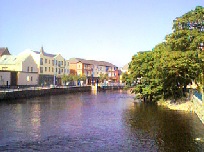Clicca sulla bandiera per leggere alcune interessanti notizie in Italiano riguardanti Sligo! |
|
All the pics and the section 'Sligo and the Yeats family' are taken from a wonderful site that you should visit! It's the Sligo site! So, my thanks for permission to reproduce this! |
|
|

|
|
|
|
In early Irish history Sligo was the passage way from the North east to the south of Ireland. Indeed some of the ancient roads are still in use today.
Sligo comes from Gaelic Sligeach so named because of the Shelly river that ran from Lough Gill to the nearby Atlantic Ocean, as AE (George Russell) told Jack B. Yeats, any place like Sligo close to the sea, that has a large body of water such as Lough Gill is a truly magical place. AE further stressed the spiritual place that the area around Ben Bulben mountain at the foot of which is the grave of William B. Yeats.
The county of Sligo originally was bordered by the Bundrowse river on the north and the Moy river to the south, in the 19th century both the southern and northern boundaries were moved closer to allow the County of Leitrim access to the sea and to give some arable land to the County of Mayo. The east boundary of Sligo county is comprised of beautiful mountain ranges such as the Dartry and the Geevagh mountains. Its history from the earliest days includes poets, storytellers, lawmakers, chieftains, soldiers and scholarly saints or Holy men and women; all reflected in the names of old Sligo families such as Harte, O'Grady, Coleman, Brehony, Ward.
A visitor to this truly magical place in 1863 was John Butler Yeats a young Dublin barrister who's grandfather had been Rector in Drumcliffe; his father's people still lived in Sligo. His visit was to an old school friend George Pollexfen a member of a respected shipping and mill owning family who originated in Cornwall and came to Sligo in the 17th century. John Butler Yeats married Susan Pollexfen and as he said himself, "My marriage gave a voice to the sea-cliffs of Sligo". Their surviving children Willy & Lily & Lolly & Jack were to make an enormous contribution to Ireland and indeed the world of art. Indeed one can truly say that their childhood in Sligo created a framework for their life ahead.
Jack Yeats lived in Sligo for 8 years from his 8th to his 16th year. His elder brother Willy and sisters Lily and Lolly spent summer holidays there. The four mixed with servants and townspeople more than the landed gentry, thus they came into contact with the stories, superstitions and beliefs of the native Irish. All of which contributed to the great poetry, drama and prose of William Butler Yeats and the paintings, plays and prose of Jack Yeats. The name Yeats translates as Dweller by the Gate, and a more appropriate name for the Yeats family and the place of shells.
|
| Cast a cold
eye On Life, on death. Horseman, pass by! WB Yeats 1865-1939 |
 |
| Back to Sligo |
|
|
|
|
|
|
| Shane loves Yeats, so
I've decided to
choose two of his poems... hope you like them!
|
|
HE WISHES FOR THE CLOTHS OF HEAVEN
Had I the heavens' embroidered cloths, Enwrought with golden and silver light, The blue and the dim and the dark cloths Of night and light and the half light, I would spread the cloths under your feet: Bet I, being poor, have only my dreams; I have spread my dreams under your feet; Tread softly because you tread on my dreams. |
|
|
TO A YOUNG GIRL
My dear, my dear, I know More than another What makes your heart beat so; Not even your own mother Can know it as I know, Who broke my heart for her When the wild thought, That she denies And has forgot, Set all her blood astir And glittered in her eyes. |
|
The first poem was written for Maud Gonne and belongs to 'The Wind Among The Reeds' (1899). Yeats' frustrated passion for Maud had by then become a real obsession. The second one was written for Iseult Gonne, the adopted daughter of his beloved Maud. It belongs to the volume 'The Wild Swans at Coole' of 1919. The poet loved Maud in vain, and she finally married Major John MacBride, one of the Irish patriots executed by the English after the rebellion of Easter 1916. The brief poem 'To A Young Girl' is particularly tender because besides summing up the story of his passionate devotion to her mother, it ideally unites the two generations - the older and the younger - through the common bitter-sweet experience of love.
|